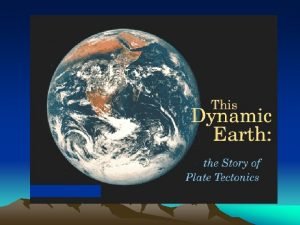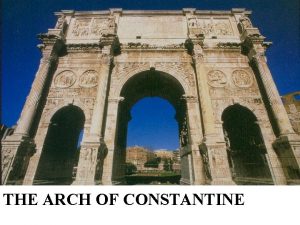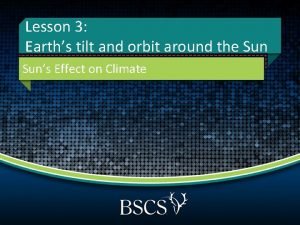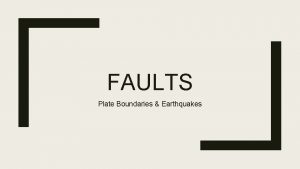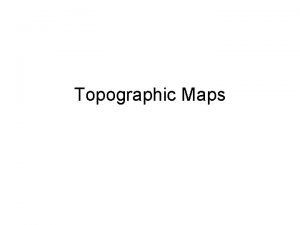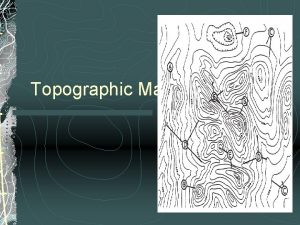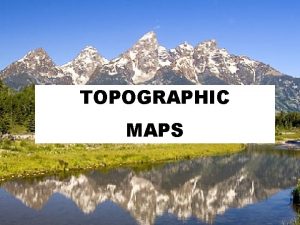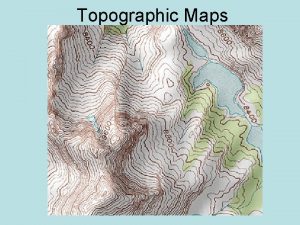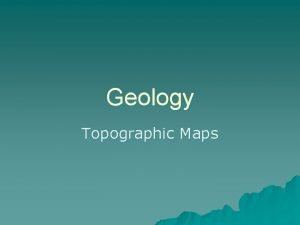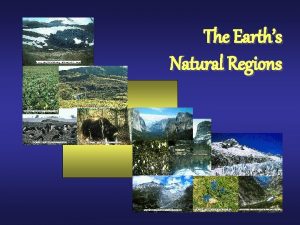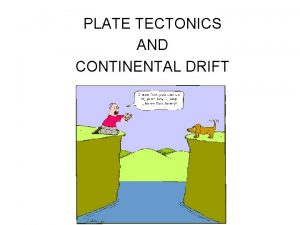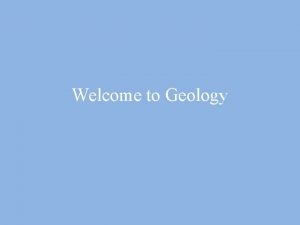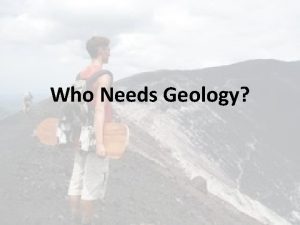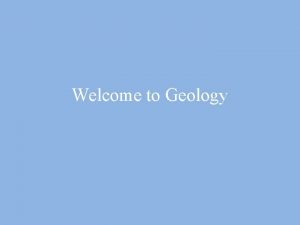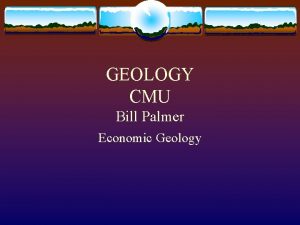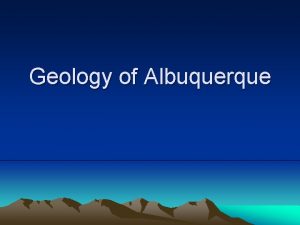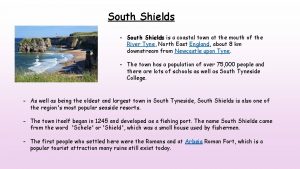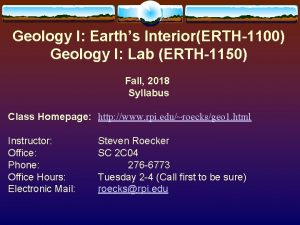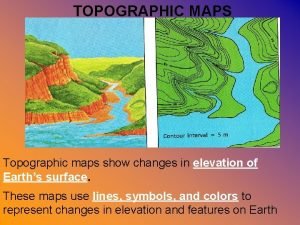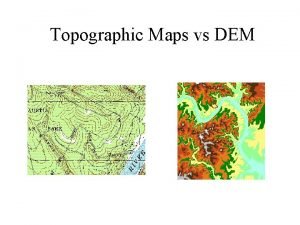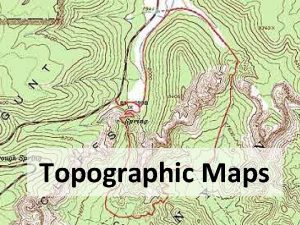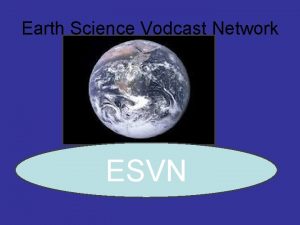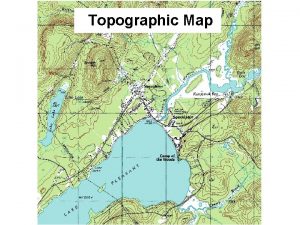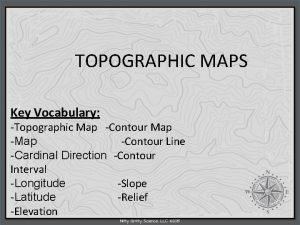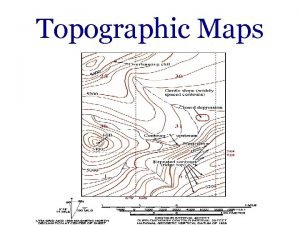Earths Topographic Regions Continental Shields GEOLOGY OF THE






























- Slides: 30



Earth’s Topographic Regions

Continental Shields

GEOLOGY OF THE USA


Atlantic Ocean Crustal Ages

Clues to Earth’s Surface • • Mountains only in certain areas Rock types differ regionally Shields in interior of continents Oceans oldest near continents and youngest towards middle of oceans

EARTH’S LAYERS • The Earth is divided into three chemical layers: – the core, – the mantle and – the crust • Chemical differences

THE CORE • The core is composed of mostly iron and nickel and remains very hot, even after 4. 5 billion years of cooling. • The core is divided into two layers: a solid inner core and a liquid outer core.

CORE GENERATES CURRENTS • Because the core is so hot, it radiates a natural heat to the upper layers. • Because of this a current of heat comes into being. Those are also known as the convection currents. • The convection currents cause the movement of the tectonic plates.

MAGNETIC FIELD • It is well known that the axis of the magnetic field is tipped with respect to the rotation axis of the Earth. • Thus, true north (defined by the direction to the north rotational pole) does not coincide with magnetic north (defined by the direction to the north magnetic pole) and compass directions must be corrected by fixed amounts at given points on the surface of the Earth to yield true directions.

Origin of the Magnetic Field • Magnetic fields are produced by the motion of electrical charges. For example, the magnetic field of a bar magnet results from the motion of negatively charged electrons in the magnet. • The origin of the Earth's magnetic field is not completely understood, but is thought to be associated with electrical currents produced by the coupling of convective effects and rotation in the spinning liquid metallic outer core of iron and nickel. • This mechanism is termed the dynamo effect.


MANTLE and CRUST

MANTLE • Composed of minerals rich in the elements iron, magnesium, silicon, and oxygen • Source of mafic minerals

CRUST • The crust is rich in the elements oxygen and silicon with lesser amounts of aluminum, iron, magnesium, calcium, potassium, and sodium. • Oceanic crust is made of relatively dense rock called basalt • Continental crust is made of lower density rocks, such as andesite and granite.

LITHOSPHERE • The lithosphere (from the Greek, lithos, stone) is the rigid outermost layer made of crust and uppermost mantle • The lithosphere is the "plate" of the plate tectonic theory

ASTHENOSPHERE • The asthenosphere (from the Greek, asthenos, devoid of force) is part of the mantle that flows, a characteristic called plastic behavior. • The flow of the asthenosphere is part of mantle convection, which plays an important role in moving lithospheric plates.

CRUST/MANTLE AGAIN • lithosphere – – hard ~100 km thick crust floats on top continental crust, 20 to 70 km thick – oceanic crust, ~ 8 km thick • asthenosphere – soft – ~3000 km thick – “fluid-like”

ISOSTACIC REBOUND A heavy load on the crust, like an ice cap, large glacial lake, or mountain range, can bend the lithosphere down into the asthenosphere, which can flow out of the way. The load will sink until it is supported by buoyancy. If an ice cap melts or lake dries up due to climatic changes, or a mountain range erodes away, the lithosphere will buoyantly rise back up over thousands of years. This is the process of isostatic rebound.

SEA-FLOOR SPREADING: the test In the late 1950's, scientists mapped the present-day magnetic field generated by rocks on the floor of the Pacific Ocean.

SEA FLOOR SPREADING HO When mapped, the anomalies produce a zebra-striped pattern of parallel positive and negative bands. The pattern was centered along, and symmetrical to, the mid-ocean ridge

SEA FLOOR SPREADING HO

SEA FLOOR SPREADING HO

SEA FLOOR SPREADING HO


SEA FLOOR SPREADING • In 1962, a geologist presented an explanation for the global rift system. Harry Hess proposed that new ocean floor is formed at the rift of midocean ridges. • The ocean floor, and the rock beneath it, are produced by magma that rises from deeper levels. Hess suggested that the ocean floor moved laterally away from the ridge and plunged into an oceanic trench along the continental margin.

EARTHQUAKES • In 1935, K. Wadati, a Japanese seismologist, showed that earthquakes occurred at greater depths towards the interior of the Asian continent. • Earthquakes beneath the Pacific Ocean occurred at shallow depths. Earthquakes beneath Siberia and China occurred at greater depths. • After World War II, H. Benioff observed the same distribution of earthquakes but could not offer a plausible explanation.

SUBDUCTION • If new oceanic lithosphere is created at mid-ocean ridges, where does it go? • The movement of oceanic lithosphere away from midocean ridges provides an explanation. Convection cells in the mantle help carry the lithosphere away from the ridge. The lithosphere arrives at the edge of a continent, where it is subducted or sinks into the asthenosphere.
 Continental shields
Continental shields Convergent boundaries features
Convergent boundaries features What happens at oceanic oceanic convergent boundaries
What happens at oceanic oceanic convergent boundaries Earths orbit seasons
Earths orbit seasons Most abundant element on earth
Most abundant element on earth Arch of constantine frieze
Arch of constantine frieze What is luna moon
What is luna moon Earths early atmosphere contained
Earths early atmosphere contained Earths roation
Earths roation What does the earths tilt cause
What does the earths tilt cause Brown earth soil profile
Brown earth soil profile Basalt
Basalt What does earths tilt do
What does earths tilt do Earths mantle
Earths mantle The earth layer foldable
The earth layer foldable Whats earths moon called
Whats earths moon called Atmospheric definition
Atmospheric definition Earths physical features
Earths physical features Whats earths moon called
Whats earths moon called Earths boundaries
Earths boundaries Earths crust
Earths crust Earths major crustal plates
Earths major crustal plates Biome near the equator
Biome near the equator What is this shape
What is this shape Earth's honey fertilizer
Earth's honey fertilizer What is earths thickest layer
What is earths thickest layer Earths layers foldable
Earths layers foldable Earths 4 spheres
Earths 4 spheres Earths interior
Earths interior Busramp shields
Busramp shields Todd shields contractor
Todd shields contractor
